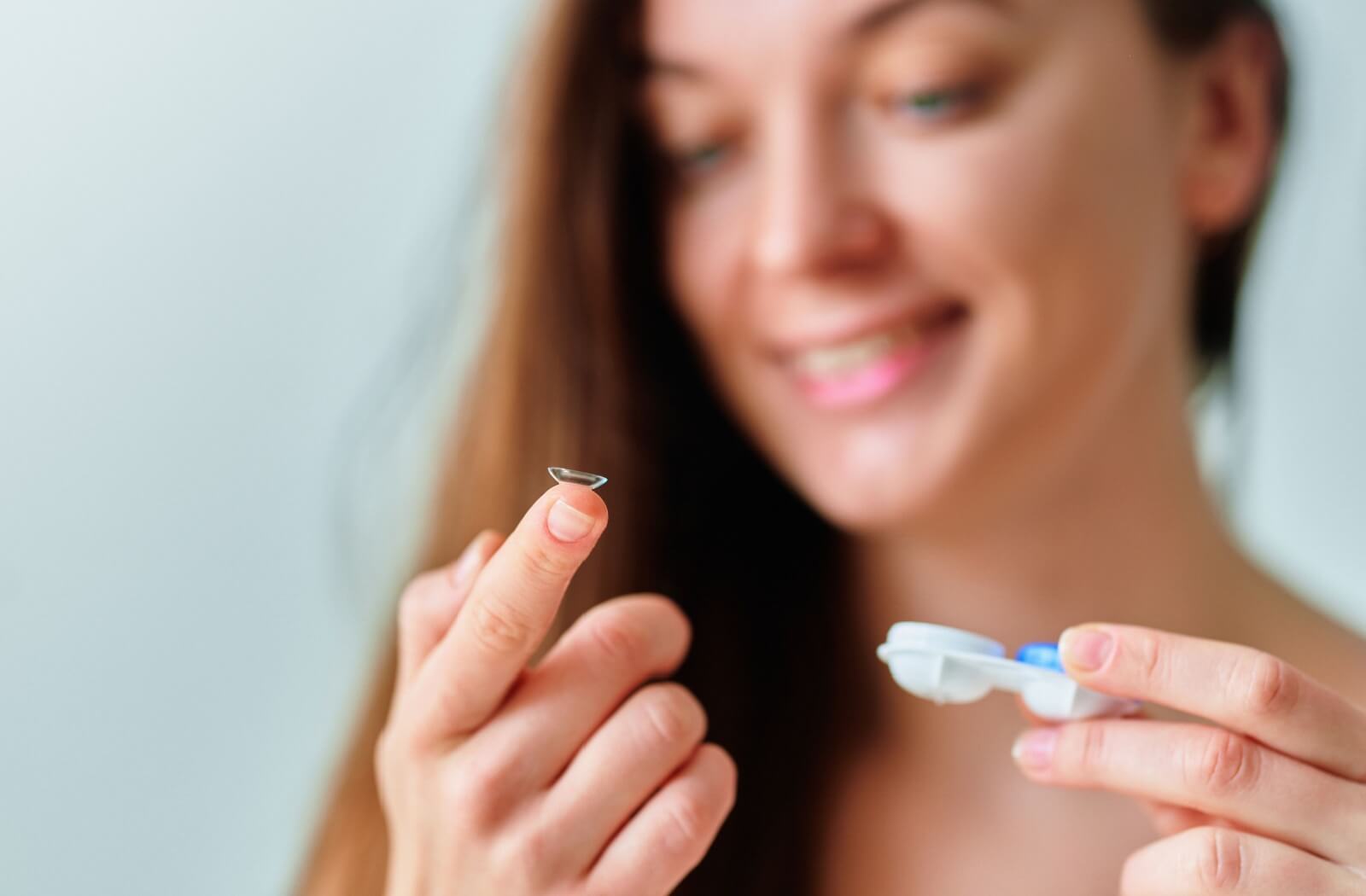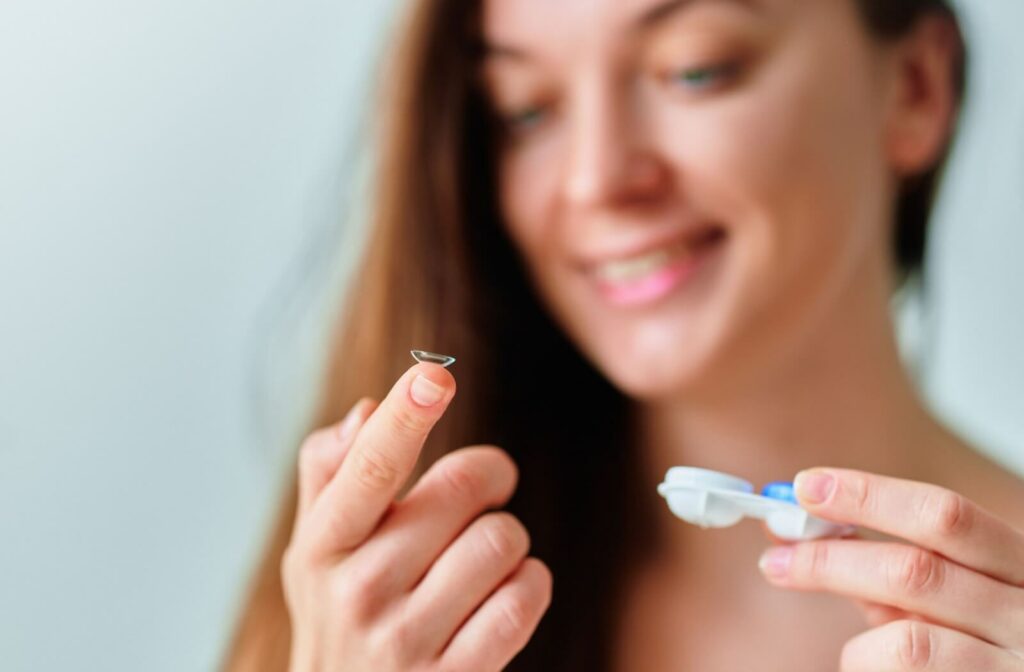If you experience dry eyes, you know how uncomfortable and frustrating it can be. For those who wear contact lenses, dry eye can be particularly challenging. The right pair of contacts, however, can make a world of difference. There are many types of contacts that are idea for dry eye patients, here are the most popular:
- Silicone hydrogel lenses
- Daily disposable lenses
- Scleral lenses
- Hybrid lenses
- Hydrogel lenses with moisture-infused technology
- Custom soft lenses
In this blog post, we’ll explore the best contact lens options for individuals with dry eye, making sure you’re well-informed to choose the most comfortable and effective solution for your condition.
Understanding Dry Eye
Before we dive into the types of contact lenses, it’s helpful to understand what causes dry eye. Dry eye occurs when your tears aren’t able to provide adequate lubrication for your eyes. This condition can stem from several factors, including decreased tear production, increased tear evaporation, or an imbalance in the composition of your tears. Various environmental conditions, such as wind, dry air, or prolonged screen time, can exacerbate these factors.
Signs of dry eye include:
- Redness: Your eyes may appear bloodshot or have a pink hue.
- Irritation: This can manifest as a burning or stinging sensation.
- A gritty feeling: It often feels like there is sand or a foreign object in your eye.
- Blurry vision: Vision may become intermittently unclear, especially after extended periods of focus.
Understanding these causes and symptoms is crucial for effectively managing dry eye and selecting the appropriate contact lenses.
Top Contact Lens Options for Dry Eye
1. Silicone Hydrogel Lenses
Silicone hydrogel lenses are a popular choice for dry eye sufferers. They allow more oxygen to reach your cornea compared to traditional hydrogel lenses, reducing dryness and discomfort. Their high oxygen permeability helps maintain eye health and comfort throughout the day.
2. Daily Disposable Lenses
Daily disposable lenses can be a game-changer for dry eye patients. Since you use a fresh pair of lenses every day, there is less build-up of proteins and allergens that can irritate your eyes. Plus, they eliminate the need for cleaning solutions, which can sometimes contribute to dryness.
3. Scleral Lenses
Scleral lenses are larger than traditional contact lenses and rest on the sclera (the white part of your eye) instead of the cornea. They create a tear-filled reservoir over the cornea, providing constant moisture and relief for dry eyes. Scleral lenses are especially beneficial for severe dry eye cases.
4. Hybrid Lenses
Hybrid lenses combine the best of both worlds—featuring a hard, gas-permeable center with a soft lens skirt. This design offers the clear vision of hard lenses and the comfort of soft lenses. The soft skirt provides a cushion, reducing irritation and dryness.
5. Hydrogel Lenses with Moisture-Infused Technology
Some hydrogel lenses are infused with wetting agents or have moisture-retaining properties. These lenses help keep your eyes hydrated throughout the day. Brands like Acuvue Oasys and Biotrue ONEday are known for their moisture retention and comfort.
6. Custom Soft Lenses
For those with unique eye shapes or severe dry eye, custom soft lenses tailored to your specific needs can provide excellent comfort. These lenses are specially designed to fit your eyes perfectly, reducing movement and irritation that can exacerbate dryness.

Tips for Wearing Contacts with Dry Eye
While choosing the right type of contact lens is crucial, here are some additional tips to help manage dry eye:
- Stay Hydrated: Drinking plenty of water helps maintain overall body hydration, including your eyes. Aim for at least eight glasses a day to ensure your body, and particularly your eyes, remain well-hydrated.
- Use Artificial Tears: Over-the-counter lubricating eye drops can provide extra moisture. These drops can be used several times a day to keep your eyes comfortable, especially during long periods of contact lens wear.
- Take Breaks: Give your eyes a break from screens and contacts throughout the day. Follow the 20-20-20 rule: every 20 minutes, look at something 20 feet away for at least 20 seconds to reduce eye strain.
- Follow Proper Hygiene: Always wash your hands before handling lenses and follow recommended cleaning routines meticulously. This helps to prevent infections and ensures your lenses stay comfortable and effective.
- Intense Pulsed Light (IPL) and Radiofrequency (RF): Talk to your eye doctor about refreshing your eye’s moisture barrier with noninvasive IPL and RF treatments. These technologies work by gently stimulating your meibomian glands, which produce the oils that keep your eyes lubricated longer. By improving the function of these glands, IPL and RF can help preserve and increase tear production.
- Consult Your Eye Care Professional: Regular check-ups ensure that your lenses are still the best option for your condition. Your eye care professional can provide personalized advice and might suggest changes to your lens type or care routine if needed.
By following these guidelines, you can help manage dry eye symptoms and maintain the comfort and health of your eyes while enjoying the benefits of contact lenses.
The Path Towards Comfortable Vision Care
Finding the right contact lenses for dry eye can significantly improve your comfort and eye health. Whether you opt for silicone hydrogel, daily disposables, scleral lenses, hybrid lenses, or other specialty lenses, there are plenty of options suited to your needs.
If you’re struggling with dry eyes and contact lens discomfort, consult with your eye care professional to determine the best solution for you. Remember, comfortable and clear vision is possible, even with dry eyes.For more personalized advice and to explore our range of contact lens options, book an appointment with us today. Your eyes will thank you!


